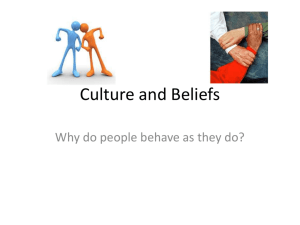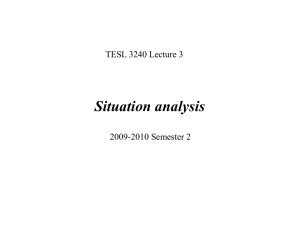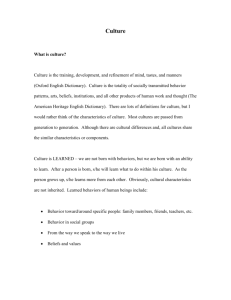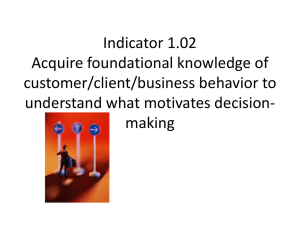Culture and Organizations
advertisement
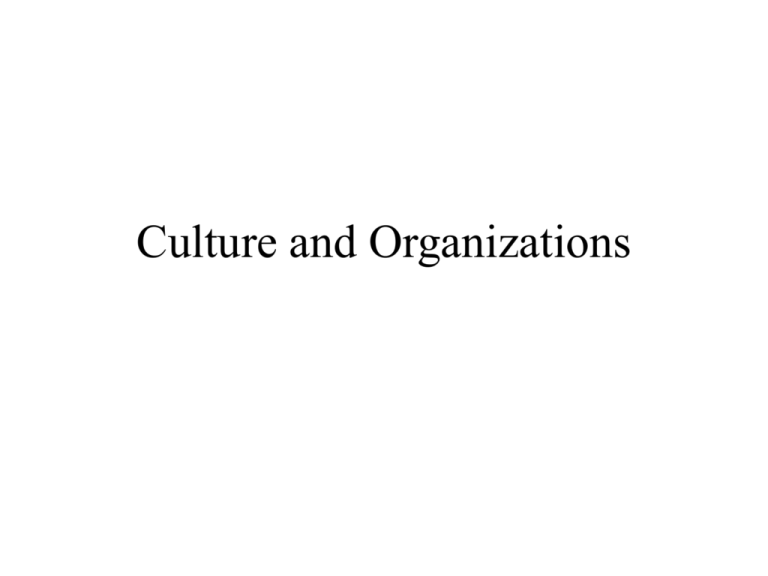
Culture and Organizations Class Outline • • • • The importance of culture Societal cultures and organizations Internal culture of organizations Video Definitions of Culture • National culture is defined as the values, beliefs, and assumptions learned in early childhood that distinguish one group of people from another • Organizational culture is similarly defined as the values, beliefs and assumptions that distinguish members of one organization from those of another Why is Culture Important? • Culture is the ‘software of the mind’ • Societal culture is an important aspect of an organization’s environment • external culture determines: – acceptable behaviors for an organization – acceptable behaviors of individuals • internal culture determines – who will be hired and retained – how individuals behave within the organization – whether an organization achieves its goals The ‘External’ Culture • National/regional cultures can be characterized in terms of five dimensions – – – – – power-distance uncertainty avoidance individualism-collectivism masculinity-femininity time orientation • Variations in these dimensions have a direct impact upon the success or failure of specific management practices Power-Distance • Meaning: – The extent to which power is distributed equally in society – the extent to which this is accepted as appropriate – the extent to which people are willing to interact across status levels • Low in the US - High in Asia and parts of Europe • influences: hierarchy, centralization, participation Uncertainty Avoidance • Meaning: – the extent to which people are threatened by uncertain and unstructured situations – high levels lead to greater reliance upon rules and procedures • US is low; France and Latin Europe are high • influences: levels of formalization and bureaucracy Individualism-Collectivism • Meaning: – The extent to which identity is derived from the self or the group – The extent to which the needs of the individual or group are prioritized • US (and all Anglo countries) highly individualistic; East Asian countries are very collectivist • Influences: emphasis on individual responsibility, and rewards Masculinity-Femininity • Meaning: – masculine orientation is doing/acquiring and values success – feminine orientation is thinking observing and values affiliation • US, Japan, and Germany are masculine; Nordic countries are feminine • Influences: merit based pay versus quality of work life and interpersonal relations Time Orientation • Meaning – long term orientation values patience, perseverance, and respect for ancestors – short-term orientation emphasizes immediate rewards, de-emphasizes history • US,UK, short term; East Asian countries long term • influence: time frame used for problem solving and organizational goals External Culture - Summary • Culture represents an important aspect of the organization’s task environment • Culture determines values and beliefs • Therefore it determines what management techniques are acceptable • Work units managed in ways that are congruent with national culture perform better Internal Culture • The values and beliefs shared among employees of an organization • As with national culture, this determines acceptable and unacceptable behavior • Transmitted through war stories, myths, and rituals • The dominant sources are the founder(s) and of course the external environment Attraction-Selection-Attrition Process • The organization’s values attract likeminded individuals • Existing managers select those who are similar to themselves in their beliefs • People who’s values do not fit with the dominant culture will ultimately feel discomfort and leave • The result is a more culturally homogeneous workforce Internal Cultures and Performance • Organizational performance requires that the culture be consistent with the goals of an organization • Internal consistency of strategy and culture: – low-cost strategy may be supported by willingness to follow rules in exchange for security – innovation strategy may be supported by culture emphasizing individual thought and freedom, risk taking Summary • Culture adds another dimension that managers must consider • fit includes external consistency of management practices with societal culture and internal consistency of organizational strategy and culture • fit results in performance and survival


